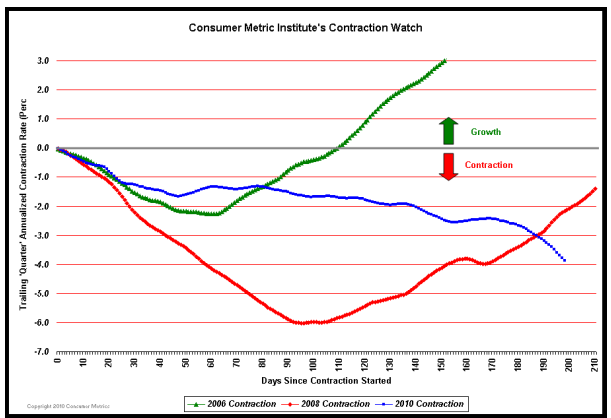
Even though St. Louis Fed President Jim Bullard created a bit of frisson last week by discussing deflation, and Treasury yields are awfully reminiscent of Japan, investors and consumers have been so conditioned to be on the watch for inflation (particularly increases in food and fuel prices), that the suck of deflation on much bigger fronts (housing and increasingly, pay) is not being weighted as seriously as it deserves to be.
Steve Greenhouse of New York Times, keying off a data release earlier in the day that showed a teeny fall in incomes, reports that more employers are rolling back pay. It’s most common among state and local government employees, but far from limited to them.
It is hard to prove in a tidy way, but I see more signs of discounting in the economy, even in goods and services aimed at upper income consumers supposedly unaffected by the downturn. There is a great deal of price cutting afoot, even in TARP/Fed funded Manhattan, via keeping nominal prices the same but offering more widespread and deeper “special” discounts or freebies. Readers are welcome to add to this list: rentals (free months, free amenities), health club memberships, cruises, decorators.
From the New York Times:
Pay cuts are appearing most frequently among state and local governments, which are under extraordinary budget pressures and have often already tried furloughs, i.e., docking pay in exchange for time off. Warning that they will have to lay off people otherwise, many governors and mayors are pressing public employee unions to accept a reduction in salary of a few percentage points, without getting days off in exchange.
At the University of Hawaii, professors have accepted a 6.7 percent cut. Albuquerque has trimmed pay for its 6,000 employees by 1.8 percent on average, and New York’s governor, David A. Paterson, has sought a 4 percent wage rollback for most state employees. State troopers in Vermont agreed to a 3 percent cut. In California, teachers in the Capistrano and Pacheco school districts have accepted salary cuts…..
In a 2010 survey by the National League of Cities, 51 percent of the cities that responded said they had either cut or frozen salaries of city employees, 22 percent said they had revised union contracts to reduce some pay and benefits, and 19 percent said they had instituted furloughs.
Some businesses are also cutting workers’ pay, often to help stay afloat or to eliminate their losses, although a few have seized on the slack labor market and workers’ weak bargaining power to cut pay and thereby increase their profits and competitiveness….
Factory owners sometimes warn that they will close or move jobs to lower-cost locales unless workers agree to a pay cut. In its most recent union contract, General Motors is paying new employees $14 an hour, half the rate it pays its long-term workers.
Sub-Zero, which makes refrigerators, freezers and ovens, warned its workers last month that it might close one or more factories in Wisconsin and lay off 500 employees unless they accepted a 20 percent cut in wages and benefits…
David Lewin, a professor of management at the University of California, Los Angeles, who has written extensively on employee compensation, says some cuts are also quietly taking place among nonunion employers.
Reed Smith, a firm with 1,500 lawyers, has cut salaries for first-year associates in major cities to $130,000 from $160,000. Warren Hospital, a nonunionized facility in Phillipsburg, N.J., ordered pay cuts of 2 to 4 percent because lower Medicaid reimbursements had squeezed the hospital’s finances…..
Fast-rising pension and health costs are making benefit costs grow more rapidly than wages, some employers say, and cutting wages is often easier than other ways to pare labor costs. But some workers say these cuts are unfair at a time when corporate profits and employee productivity have risen strongly.
With this sort of pressure on incomes (both direct and indirect; even if an employee’s compensation is intact, there is no assurance it will stay that way), it’s no wonder consumer confidence is plunging. In addition, the Consumer Metrics Institute, which maintains a set of indexes on consumer spending, sees patterns that bode ill (hat tip reader Scott):
Since last week our ‘Daily Growth Index’ has dropped significantly, putting the trailing 91-day moving ‘quarter’ at a contraction level that would place a similar calendar quarter of GDP growth below the 5th percentile of all quarters since 1947. Under normal circumstances we might expect a quarter that bad once in slightly over 5 years:

The chart above clearly shows that things were much better one year ago, when the recovery was peaking in late August and early September of 2009….The decline during in the 4th quarter of 2009 was spectacular, and it has been steady throughout 2010. For those of you who are curious, the last time that our ‘Daily Growth Index’ passed the 5th percentile on the way down was on July 16th, 2008.
Yves here. In another shades of Japan development, the consumer falloff, while not as bad as 2006 or 2008, looks more stubborn:
More telling perhaps for economic forecasts is that the longevity of the current contraction is somewhat rarer than its nominal severity. Our 183-day moving ‘two consecutive quarters’ growth index would place that 6-month span in the 4th percentile of consecutive quarters since 1947. Only roughly one in every 25 six-month periods since the first Truman Administration would have been worse. The lingering nature of the current contraction can be seen in our Contraction Watch:

…. As we approach 200 days of contraction the 2010 event is now worse on a day-by-day basis than either of the two earlier slowdowns, and unlike the prior two events the current one has not yet formed a bottom.
